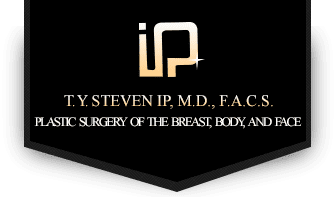There are a number of decisions to make during your breast augmentation process. You will work closely with your surgeon to decide which options are best suited to your physical and aesthetic needs. These are the 4 S’s of breast augmentation to keep in mind so you can achieve the most natural and beautiful results possible.
 1. Saline vs. Silicone
1. Saline vs. Silicone
Your implants can be comprised of either saline or silicone material. The type of implant you choose will impact the overall look and positioning of your breasts. Your surgeon will make a recommendation as to what is the best implant material for your breast augmentation depending on your physical characteristics, placement choice, and price point.
- Saline implants are filled with a saltwater solution and are FDA approved for those over 18. While the more cost-effective option, saline implants haven’t been as popular in recent years. This may be due to the fact that they create a more noticeably augmented look and are more prone to visible surface irregularities.
- Silicone implants are created from a cohesive silicone gel and are FDA approved for those over 22. Silicone implants are considered to create a more natural looking and feeling breast. However, damage to the implant is more difficult to detect and leak detection requires an MRI scan.
2. Surgical Incision
Your surgical incision location can vary depending on your implant size, placement location, and how opposed you are to visible scarring. Your surgical incision may impact breastfeeding functionality, and you should discuss this with your surgeon if retaining your ability to nurse is a concern.
- Inframammary incisions run along the breast crease. Larger implants can be placed through a crease incision, but you may develop visible scarring depending on the fall of your breast tissue.
- Periareolar incisions are created along the border of the areola. This results in minimal visible scarring, but it does limit the size of the implant that can be placed. It is best suited for saline implants, which can be inserted empty and filled in the breast pocket.
- Transaxillary incisions are only used to place saline implants because the incision is created in the armpit and the implants are then placed via an endoscope.
- Transumbilical incisions are only available to be placed using saline implant because the incision is created in the belly button and the implants are placed via an endoscope.
3. Size
Choosing a properly sized implant is important to creating natural and beautiful results. Implants that are too large for your frame can create a noticeably augmented appearance, or stretch the skin too much. When the skin is pulled too tightly over an implant, you are more likely to develop visible surface irregularities. Overbearing implants are more likely to displace over time or weaken breast tissue, which results in sagging.
When considering the best implant size for a patient, we take the following into mind:
- Personal aesthetic desires
- Chest width
- Thickness of the breast tissue
- Where the implant will be placed
4. Style or Shape
Style and shape of your implants can include round, teardrop, smooth, or textured. These finer characteristics of implant type will impact the positioning of your implants, as well as their visibility through the skin. Most patients use smooth, round implants for their augmentation. Teardrop or textured implants may be chosen if there is a fear of complication. Your surgeon will recommend the best style and shape for you during your consultation.


